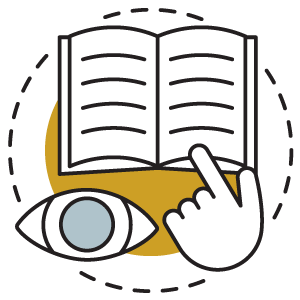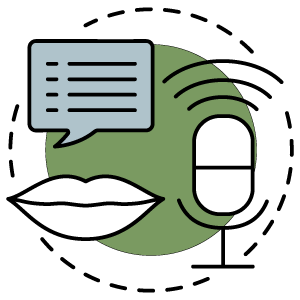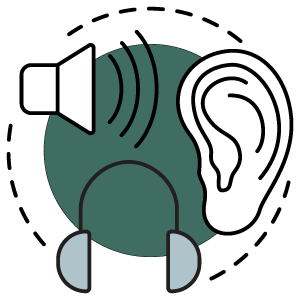Civic Lab Online: Invisible Illnesses & Disabilities
Posted on October 1, 2021 at 6:00 am

About Civic Lab Online
Civic Lab Online provides information on issues facing our community for you to explore. Take a look at thought-provoking materials for teens and adults that allow us to engage in open conversation and grow together as a community. You’ll find all past topics on the Civic Lab Online web page.
Fast Facts
An increasing number of Americans have been and continue to be diagnosed with conditions that can’t be seen by the naked eye. How do we create a society that provides access to people with debilitating medical conditions?
What is an “invisible illness”? What’s the difference between an invisible illness and an invisible disability?
An invisible disability is a physical, mental, or neurological condition that is not visible from the outside, yet can limit or challenge a person’s movements, senses, or activities. If a medical condition does not impair normal activities, then it is considered an illness and not a disability. Ninety-six percent of people diagnosed with a chronic medical condition live with an invisible illness.
While there is no official master list of all invisible disabilities and illnesses, the University of Massachusetts published a document in 2015 listing 51 specific conditions. Many of them fall under broader topics such as chronic pain, chronic fatigue, mental illness, and chronic dizziness. Some examples include depression, cancer, multiple sclerosis, chronic fatigue, and diabetes. The study cited that approximately 10% of Americans at the time of the study had a medical condition that would be considered an invisible disability.
According to the Massachusetts study, half of Americans have a chronic medical condition (a persisting and long-lasting medical problem, invisible or not) but not all of those illnesses are considered disabilities. An illness is only considered a disability when it interferes with the person’s normal everyday activities, as defined by the Americans with Disabilities Act of 1990, the landmark legislation that defines the rights of those with disabilities. A condition can still be a disability according to these rules even if the person does not fit the popular image of someone who is disabled or can competently manage their obligations.
Invisible Disabilities Awareness Week is October 17–23, 2021, and is hosted by the Invisible Disabilities Association. The week focuses on broadening the public’s knowledge of these conditions.
Aren’t people just making up illnesses to get attention?
Some invisible illnesses can be quickly diagnosed by doctors and verified by tests. No one should tell you that you don’t have cancer if a doctor says you do, even if your appearance never changes.
Others are harder to verify. For example, fibromyalgia (a state of debilitating muscle and joint pain throughout the body) appears to be linked to changes in how the brain and spinal cord process pain signals, but there is no single test for this disorder and symptoms can be mistaken for at least a dozen other illnesses.
Though some diseases and conditions have more dedicated research, are more widespread, and more easily diagnosed, all of the “invisible illnesses” named by the University of Massachusetts have specific symptomology listed by the Centers for Disease Control and Prevention (CDC).
How many people have an invisible disability compared to a visible disability? Is it rare?
In 2014, 27.2% (or 85.3 million) of people living in the U.S. had a disability, according to the Survey of Income and Program Participation (SIPP) conducted by the U.S. Census Bureau. This includes those with learning disabilities and other non-debilitating conditions. Of those, 17.6% of Americans (55.2 million people) had a severe disability.
The probability of having a severe disability increases with age—less than 1 in 10 for adults between 18 and 24 years and over 90% of people living in nursing homes or assisted living.
In the survey, disabilities were determined based on questions that included difficulty with Activities of Daily Living (ADLs), and Instrumental Activities of Daily Living (IADLs). ADLs include activities such as getting around inside the home, getting in or out of bed or a chair, bathing, dressing, eating, and toileting. Examples of IADLs would be going outside the home, keeping track of money and bills, preparing meals, doing light housework, taking prescription medicines in the right amount at the right time, and using a phone.
The census does not specifically ask about invisible illnesses. However, we do know that 7.7% (18.4 million) of all adults used a cane, crutches, or a walker to assist with mobility, and 2.3 percent (5.5 million) used a wheelchair, at the time of the survey. While some disabled people may use other means of assistance, this still leaves the majority without an easily identifiable marker of disability.
What does the law say about invisible illnesses? Is there legislation specific to invisible illnesses?
Two states, Alaska and Colorado, have approved the Invisible Disability Association’s National Disability ID Initiative. This legislation hopes to prevent wrongful ticketing for using a handicapped space and the wrongful arrest of people who cannot communicate their intent to cooperate. People with disabilities such as autism, neurological disorders, and other invisible illnesses may voluntarily disclose a disability and have a symbol put on their government issued ID. The symbol does not disclose their disability but does identify them as disabled.
The American Disabilities Act’s Revised Requirements for Service Animals maintain that the dog must be under the control of the handler and housebroken. Staff may ask if the dog is a service animal and what service the animal provides, but not specifically what the disability is. This applies whether the disability is invisible or not.
The Revised Code of Washington allows the following groups to use a placard from the Department of Licensing to access a handicapped space: people who cannot walk two hundred feet without stopping to rest; are limited in ability to walk; cannot walk without the use of or assistance from an assistive device; use portable oxygen; are restricted by lung disease; are impaired by cardiovascular disease or a cardiac condition under standards accepted by the American Heart Association; have a disability resulting from an acute sensitivity to automobile emissions; are legally blind and have limited mobility. This applies whether the disability is visible or not.
The Rehabilitation Act of 1973 ensures that students with disabilities receive necessary accommodations to be educated along with their peers (for example, an adjustment in class schedule to take insulin for someone with diabetes, or extra test time for a student with learning disabilities). This includes visible and invisible disabilities.
Read, Watch, Listen

READ
Esposito, Lisa. Life With an ‘Invisible’ Illness. U.S. World and Business Report, 2016. https://health.usnews.com/health-news/patient-advice/articles/2016-01-01/life-with-an-invisible-illness
This brief article provides examples of how real families are balancing their medical conditions and the societal expectation to “act normal”, as well as advice to help those without a condition interact successfully with the invisibly disabled.
Hadid, Yolanda with Bender, Michele. Believe Me: My Battle with the Invisible Disability of Lyme Disease. St. Martin’s Press, 2017. https://scld.overdrive.com/media/3348564
In early 2011, Yolanda Hadid was struck by mysterious symptoms including brain fog, severe exhaustion, and migraines. Over the months and years that followed, she went from being an outspoken, multi-tasking, hands-on mother of three and reality TV star to a woman who spent most of her time in bed. Yolanda was turned inside out by some of the country’s top hospitals and doctors, but due to the lack of definitive diagnostic testing, many were quick to treat her symptoms but could never provide clear answers to their possible causes.
Rehmeyer, Julie. Through the Shadowlands: A Science Writer’s Odyssey into an Illness That Science Doesn’t Understand. New York: Rodale, 2017. https://scld.overdrive.com/media/3287732
The top specialists in the world were powerless to help, and research on Julie Rehmeyer’s disease, chronic fatigue syndrome, was at a near standstill. Going against both her instincts and her training as a science journalist and mathematician, she followed the advice of strangers she’d met on the Internet. Their theory—that mold in her home and possessions was making her sick—struck her as wacky pseudoscience. But they had recovered from chronic fatigue syndrome as severe as hers. To test the theory that toxic mold was making her sick, Julie drove into the desert alone, leaving behind everything she owned. With only her scientific savvy, investigative journalism skills, and her dog, Frances, to rely on, Julie carved out her own path to wellness—and uncovered the shocking scientific neglect and misconduct that had forced her and millions of others to go it alone.
Selak, Joy H. and Overman, Steven S. You Don’t Look Sick! Living Well with Chronic Invisible Illness (2nd Edition). Springer Publishing Company, 2012. https://scld.overdrive.com/media/1270538
The authors address such practical aspects as hiring a doctor, managing chronic pain, coping with grief and loss of function, winning battles with health and disability insurers, countering the social bias against the chronically ill, and recognizing the limitations care for chronic illness and charting a path for change and more.

WATCH
Brain On Fire. Dir. Barrett, Gerard. Denver and Delilah Productions, Broad Green Pictures, Foundation Features, 22 June 2018 (USA). Film. https://www.netflix.com/title/80128245
Based on the true story of Susannah Cahalan, a capable journalist for the New York Post who cannot explain her sudden erratic behavior. She explains to her parents that it feels like her “brain is on fire,” but there are many diagnoses before her neurological disorder is found and treated.
Unrest. Dir. Brea, Jennifer. Shella Films, 22 September 2017 (USA). Film. https://www.unrest.film/
When Harvard Ph.D. student Jennifer Brea is struck down by a fever that leaves her bedridden, she sets out on a virtual journey to document her story. Doctors tell Jennifer it’s “all in her head.” Determined to live, she turns her camera on herself and her community, a hidden world of millions confined to their homes and bedrooms by ME (myalgic encephalomyelitis), commonly called chronic fatigue syndrome.

LISTEN
Spero, Harper. Made Visible podcast, Harper Spero, 2020. https://harperspero.com/madevisible
Made Visible is a podcast that gives a voice to people with invisible illnesses. This podcast aims to change the conversation around invisible illnesses, helping those who experience them—whether as patients, caregivers, or friends or family members—feel more seen and heard.
Digital Resources

Once you access this resource, search for “invisible illness” or “chronic illness” to learn more.

Find authoritative information on a full range of health-related topics.

Other Health & Wellness Digital Resources
Our Digital Library has health and wellness resources for you to explore.
Print & Other Materials in Our Catalog
Search our catalog for books, large print, eBooks, and audiobooks on any topic.
Downloadable Documents
Fast Facts: Invisible Illnesses & Disabilities
Read, Watch, Listen: Invisible Illnesses & Disabilities
Tags: adults, civic lab, disabilities, health, invisible illness, teens
